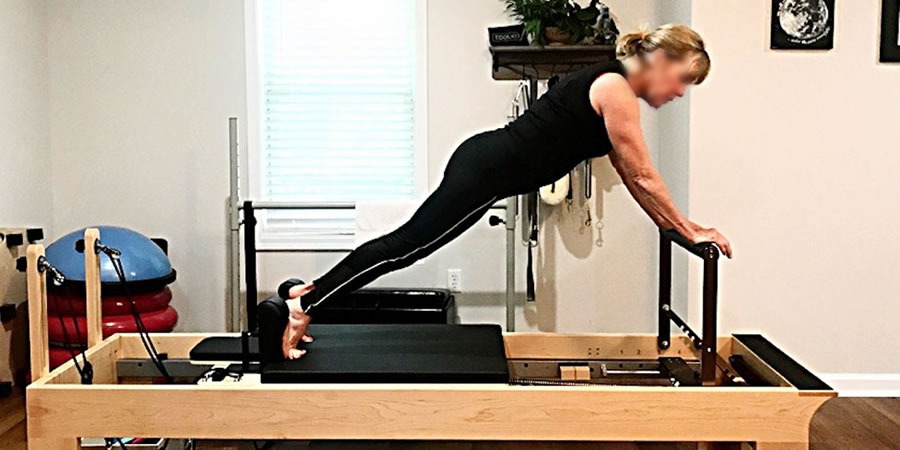While Covid was terrible for most Pilates studio owners and gym owners, some independent instructors teaching from home over platforms like Zoom had a different experience.
Now that they no longer split their fees with a studio owner or gym, they may have actually seen their hourly rate go up. Now, as we move back to in-person teaching, many of these itinerant teachers are wondering, as the CEO of their own burgeoning businesses, why they should ever go back to the old math.
Taking into account lifestyle, salary, and liability, independent instructors are evaluating whether their Covid-era accommodations (most notably, teaching via Zoom) actually serve them better than the traditional model of doing business going forward. I recently spoke with a couple of independent instructors as well as a Pilates studio owner to discuss the pluses and minuses of returning to the studio setting or going it alone at home.
Daniela Escobar, the owner of Westwood Pilates, a fully equipped Pilates studio in Los Angeles, California, had to open and close her studio multiple times. Now her studio is fully open and featuring in-person, Zoom, and also hybrid classes. She has both independent contractors and employees at her studio.
Escobar values the “sense of community that you feel when you work with other instructors” that can’t be replicated in the stay-at-home-by-yourself-teaching-on-Zoom model we’ve been living for the past 15 months.
“TEACHING IN A HOME STUDIO ON ZOOM WITH A PARTIAL COLLECTION OF APPARATUS IS DIFFERENT THAN WORKING THE WHOLE SYSTEM IN A FULLY EQUIPPED PILATES STUDIO.”
“Small props can help but they are not a replacement for studio apparatus like the Reformer,” says Escobar.
Westwood Pilates is also home to Pilates “elder” Jay Grimes, and attracts instructors from all over the world intent on honing their craft. Escobar has created an amazing learning environment with her team of instructors. She appreciates “the exchange that happens among teachers in a studio. When you work as a team, we can all learn from each other.”
Melissa Greenwood is an independent instructor in the Los Angeles area. Since the beginning of the pandemic, she has moved online and created a small home studio for the first time. Pre-pandemic times had her commuting to several studios during her work week.
“My main source of income went belly up due to the pandemic, as it did for the studio owners I had once worked for,” she says. “Now that I am vaccinated and most of my clients are, too, I’ve opened up my home to a select few for in-person lessons on my Reformer, Wunda Chair, Spine Corrector and Contrology folding Mat.”
Working from home means she can work more consistently and most importantly, for herself, generating a more sustainable income post-pandemic. “If I were to return to in-studio teaching, and again, someday I might, I’d have to commute again. That driving time cuts down the number of hours I can actually teach and make money,” says Greenwood.
My own experience as a home studio owner since 2010 was similar. Once in my personal Pilates space, I no longer had to split my time between several studios during the week. This change was not easy. At the time, I wondered if anyone would want to come to someone’s home to exercise rather than visit a commercial studio space. Sometimes it’s hard to think “outside the box” when it comes to how our industry has always conducted business.
THE PANDEMIC HAS BLOWN THE BOX WIDE OPEN.
“I used to work 14-hour days. Now I am able to keep work within a 12-hour span,” Greenwood explains. “I used to teach six days a week. Now I’ve scaled back to five. I used to work every holiday. Now I take many holidays off. With the extra time, I’ve been pursuing other interests I had forsaken, like writing and singing.”
Another instructor I spoke with, Bobbi Green in Los Angeles, teaches Pilates as well as also other modalities including energy work, so hands-on is a very important part of her teaching that can’t be replicated on Zoom.
Green had only a few clients at the time of the pandemic. With an average age of 75, they tended to be less experienced with all things digital and thus resistant to working out over Zoom. Green could sympathize: until Covid, Green herself didn’t even have a computer. In addition, the hilly, somewhat remote area of LA that is home to the majority of her clients tends to offer unpredictable wifi service, making it even more difficult for Zoom lessons.
Without her Pilates teaching schedule keeping her busy, Green had to prioritize self-care during the year of staying at home. Because she lives alone, she made it a priority to visit a nearby ranch to be in the fresh air and interact with horses and other animals.
“QUARANTINE REALLY TAUGHT ME THE IMPORTANCE OF MOVING.”
“Too much stay-at-home time gave me perspective about clients who don’t move anymore and get depressed. I now understand how just moving lifts them out of depression,” Green adds.
In my own home Pilates business, I welcome new ways of bringing the Pilates Method to the people. Covid has normalized the teaching of Pilates in a virtual format and gives clients yet another option to get in their workout. And I’m pretty psyched about the dawn of so-called ‘hybrid’ classes, or small groups of students in-studio and online participating in the same class.
As for our clients, whether they’re getting into the studio or working out online, they’ll gain greater consistency, see more results, and continue their lives in a vibrant and dynamic fashion.
Source: https://www.pilatesanytime.com/Pilates-Blog/1255/Why-Should-I-Bring-My-Clients-Back-to-the-Studio








